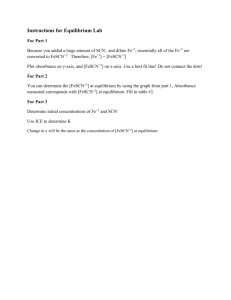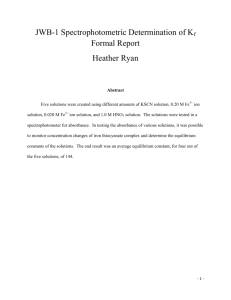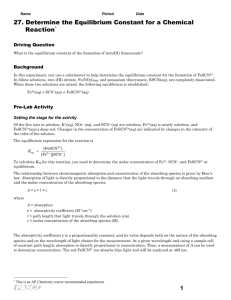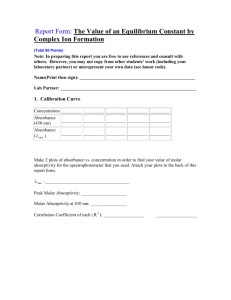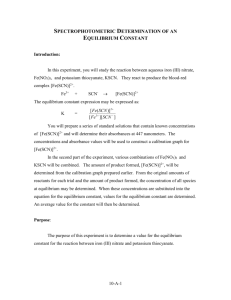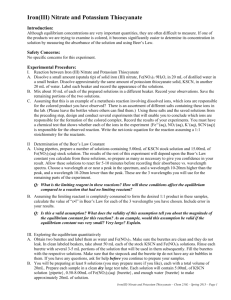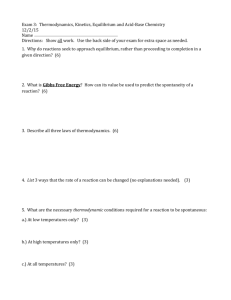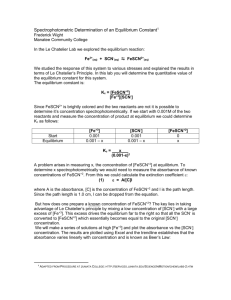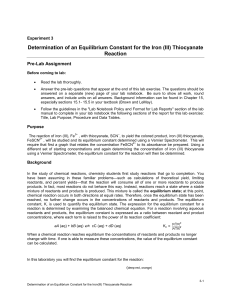Determination of an Equilibrium Constant
advertisement
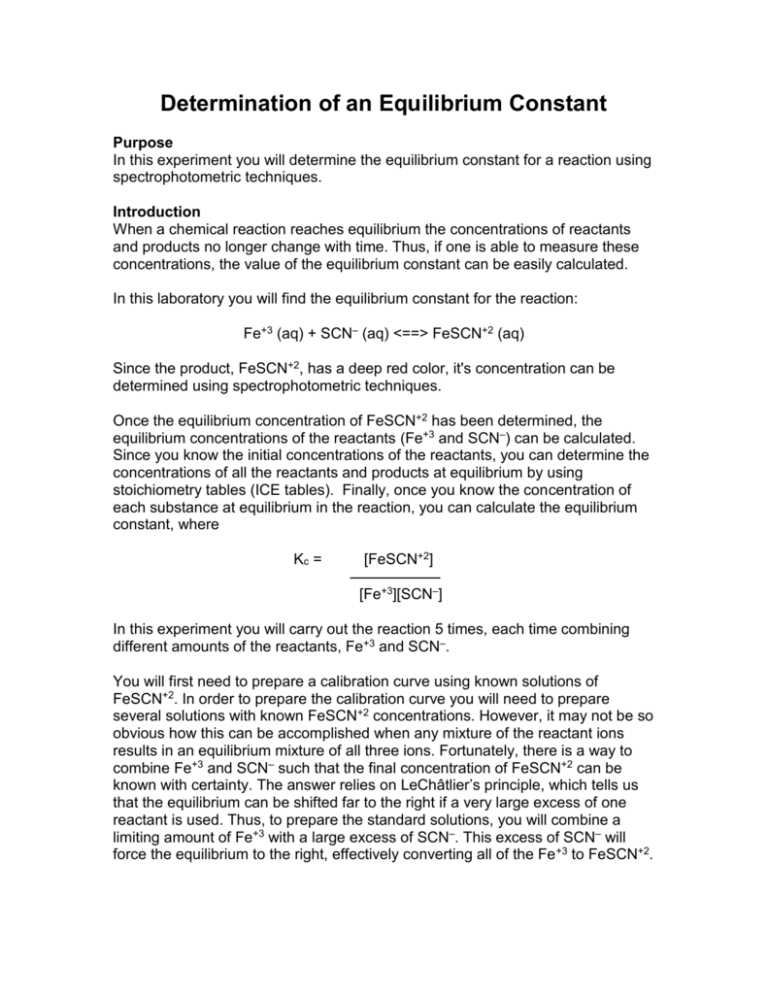
Determination of an Equilibrium Constant Purpose In this experiment you will determine the equilibrium constant for a reaction using spectrophotometric techniques. Introduction When a chemical reaction reaches equilibrium the concentrations of reactants and products no longer change with time. Thus, if one is able to measure these concentrations, the value of the equilibrium constant can be easily calculated. In this laboratory you will find the equilibrium constant for the reaction: Fe+3 (aq) + SCN– (aq) <==> FeSCN+2 (aq) Since the product, FeSCN+2, has a deep red color, it's concentration can be determined using spectrophotometric techniques. Once the equilibrium concentration of FeSCN+2 has been determined, the equilibrium concentrations of the reactants (Fe+3 and SCN–) can be calculated. Since you know the initial concentrations of the reactants, you can determine the concentrations of all the reactants and products at equilibrium by using stoichiometry tables (ICE tables). Finally, once you know the concentration of each substance at equilibrium in the reaction, you can calculate the equilibrium constant, where Kc = [FeSCN+2] [Fe+3][SCN–] In this experiment you will carry out the reaction 5 times, each time combining different amounts of the reactants, Fe+3 and SCN–. You will first need to prepare a calibration curve using known solutions of FeSCN+2. In order to prepare the calibration curve you will need to prepare several solutions with known FeSCN+2 concentrations. However, it may not be so obvious how this can be accomplished when any mixture of the reactant ions results in an equilibrium mixture of all three ions. Fortunately, there is a way to combine Fe+3 and SCN– such that the final concentration of FeSCN+2 can be known with certainty. The answer relies on LeChâtlier’s principle, which tells us that the equilibrium can be shifted far to the right if a very large excess of one reactant is used. Thus, to prepare the standard solutions, you will combine a limiting amount of Fe+3 with a large excess of SCN–. This excess of SCN– will force the equilibrium to the right, effectively converting all of the Fe +3 to FeSCN+2. Once your calibration curve has been prepared you will be able to prepare a series of equilibrium mixtures and determine the equilibrium constants for each trial, as outlined above. Each prepared mixture will have a different red color. The intensity of the color determines the amount of FeSCN2+ ion that is present. In order to determine how the color relates to the concentration of the ion, a spectrophotometer will be used. Spectrophotometers measure the amount of light that is absorbed by a certain color at a given wavelength. A detector inside the spectrophotometer accurately determines the amount of light absorbed and reports the value using an analog or digital readout. By using the amount of light that was absorbed by the sample, you can determine the concentration of the FeSCN2+ ion at equilibrium. Spectrophotometer Operation 1. Turn on the power switch/zero control for a 30 minute warm up period. 2. Select the wavelength 447 nm with the wavelength control 3. Zero the Spectrometer a. With the sample compartment empty and closed adjust the zero control so the meter reads 0% transmittance b. Insert a reference blank (deionized water) into the sample compartment, close the cover, and adjust the transmittance/absorbance control to set the meter to 100%. 4. Insert each sample and read the corresponding absorbancy – watch for significant figures!!! Part I — Preparation of the Calibration Curve (The curve solutions will be prepared prior to class; it is the groups responsibility to determine each substances absorbance) 1. Obtain 0.200 M Fe(NO3)3 in 0.50 M HNO3. 2. Obtain 2.00 x 10-3 M KSCN. 3. Set up four 100 mL Volumetric Flask. Add the appropriate volume of 2.00 x 10-3 M KSCN according to the below table, and dilute the volume to 100 mL using the 0.200 M Fe(NO3)3 in 0.50 M HNO3. Shake the solutions to ensure they are well mixed. Flask # 2.00 x 10-3 M KSCN Concentration of FeSCN2+ (mL) M 1 1.00 2.00 x 10-5 2 2.50 5.00 x 10-5 3 5.00 1.00 x 10-4 4 10.00 2.00 x 10-4 4. Set the spectrophotometer to a wavelength of 447 nm and measure the absorbance of each solution. 5. Using the concentration (X) and absorbance (Y) data to plot a standard curve to determine the linear relationship. (You may use Graphical Analysis or Microsoft Excel to generate your graphs) Part II — Determination of the Equilibrium Constant 1. Clean and dry 5 test tubes. Set up 5 test tubes in a rack. 2. Obtain 0.0020 M Fe(NO3)3 in 1.0 M HNO3 from your basket. 3. Obtain 0.0020 M KSCN from your basket. 4. Use pipets to mix the solutions of Fe(NO3)3 (Fe3+ source) , 0.0020 M KSCN (SCN– source), and H2O in the proportions listed below. Use glassstirring rods to insure that the solutions are well mixed. Be careful not to mix up the pipets or stir rods! Use a different pipet for each solution. (These will be labeled for you!) Test Tube # 0.0020 M Fe(NO3)3 0.0020 M KSCN H2O (mL) (mL) (mL) 1 5.00 1.00 4.00 2 5.00 2.00 3.00 3 5.00 3.00 2.00 4 5.00 4.00 1.00 5 5.00 5.00 0.00 5. Measure and record the absorbance of each solution at 447 nm using the spectrophotometer. Calculations and Analysis 1. If you have not yet done so, prepare a graph of [FeSCN+2] vs absorbance for the four standard solutions. Be sure to find the linear relationship of the line that you graph. 2. Calculate the equilibrium [FeSCN+2] for each test tube using the measured absorbance and the equation of the line from graph. 3. Compute the initial [Fe+3] and [SCN–] in each of the five test tubes. Be sure to take into account the total volume (10mL) when the solutions are mixed. (M1V1= M2V2) 4. Calculate the equilibrium concentrations of both Fe+3 and SCN– for each of the five test tubes using ICE tables. 5. Find the Kc for each of the established equilibriums by using the calculated equilibrium concentrations and the Kc expression. 6. Determine your average Kc value as well as the percent relative error for each of your five Kc.
